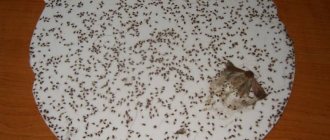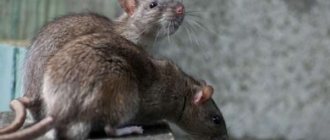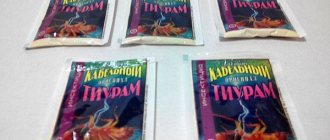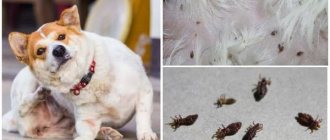- Meet the human flea
- Description of the parasite
- Do fleas live on humans?
- Reasons why fleas cannot live on humans
- Where do human fleas live?
- Exception to the rule
- Why are human fleas dangerous?
- How to protect yourself from parasites?
The main carriers of fleas into homes are domestic cats and dogs. Insects also move into the apartment on clothes and shoes, enter through basements and open windows. They annoy not only pets, but also other family members, leaving painful bites. Therefore, the question arises whether fleas live on humans, or whether these ectoparasites just come to visit.
Meet the human flea
Scientists have described 2,086 species, 200 genera and 15 families of insects. The official species “human flea” exists and belongs to the common family.
Common types of fleas
- Felines;
- Canine;
- Rat;
- Rabbit;
- Human.
However, do not rush to conclusions that there are fleas on people. The name of the insect does not indicate its habitat. All of the above types of ectoparasites feed on the blood of any mammals. For example, cat fleas bite cats, dogs, humans, pigs, and cows.
Where, when and how can you get infected with fleas?
A person may well encounter blood-sucking insects almost anywhere: in his own home, outdoors in the forest, at work in the agricultural industry, or when going hunting.
Most often, fleas are transmitted to people from their pets - cats or dogs that live in the house. According to statistics, 3 out of 4 pets are infected with fleas. However, it is not necessary that these are domestic animals. The primary source may well be rodents and stray street animals.
The largest number of all parasites and their larvae live where the domestic animal sleeps and rests. This is a booth, bed, bedding, playpen or enclosure. After all, for fleas these places are the most comfortable for breeding, feeding and shelter.
For example, dog fleas often jump onto a person while in a kennel. Here the females lay eggs and very quickly begin to want to eat again. Even a person just passing by can easily become their victim.
Other habitats for fleas are:
- Natural resting and nesting places for animals: burrow, hollow, nest. Being near these places, hunters, biologists, and loggers risk being infected with fleas.
- Agricultural farms and other livestock complexes. There are a lot of fleas on rabbit farms and fur farms. Even though disinfestation is often carried out in such places, many workers are still attacked and bitten by fleas.
- Natural places and shelters for small rodents: meadows, ravines in the forest, fields. Usually a person does not notice the burrows of these animals and thus becomes a victim of a huge number of fleas.
- Premises infested with fleas: private and apartment buildings, their attics and basements.
Description of the parasite
The homeland of the human flea is South America. In the past, it was one of the main carriers of plague along with the rat flea.
The length of the body does not exceed three millimeters, the color is dark brown. A durable chitinous shell protects from damage, and bristles on the paws provide adhesion to animal fur.
The insect's jumps reach 30 centimeters in height and half a meter in length. The human flea has an excellent reaction, so it is almost impossible to catch it. He prefers cats and dogs as victims, but sometimes he doesn’t mind feasting on human blood.
The female is capable of laying up to 500 eggs. Metamorphosis into an adult insect takes from 2 weeks to one year.
Features of parasitism
The life cycle of fleas does not depend on a specific animal. They need blood to reproduce. They receive the necessary portion and return to their usual habitat. In city apartments this could be:
- pet beds and houses:
- mattresses;
- sofas and armchairs;
- textile toys;
- spaces behind furniture;
- cracks in the floor and poorly pasted wallpaper.
The flea remains viable even if it does not receive blood for a long time. In this case, suspended animation (hibernation) does not occur. The parasite loses the ability to reproduce, but continues to move in search of food. Fleas recognize their prey thanks to their excellent sense of smell and sensitivity to temperature fluctuations and vibrations.
Reasons why fleas cannot live on humans
- Temperature
- No clues
- Precautionary measures
- Protection of future offspring
Fleas love warmth. The human body temperature is lower than that of cats, dogs and other mammals, so it is uncomfortable for insects to live on it.
Fleas require a thick coat of fur to stay on the victim's body and not fall off. Human skin is smooth. Can fleas live in human hair? No, either, because human hair is not as thick as animal hair.
Unlike other insects (ticks, mosquitoes, bedbugs, lice), fleas do not secrete an anesthetic substance during a bite. The affected person makes sudden movements and drives the insect away. The flea is forced to jump to avoid being caught. There is no point in living where you are constantly disturbed.
In order to preserve her offspring, the female flea lays eggs in secret corners: pet fur, carpets, baseboards, under beds and sofas. If they multiply on a person’s body and hair, then due to the lack of attachment, the eggs simply end up on the floor.
Are fleas transmitted from dogs to humans?
Are dog fleas transmitted to people? More likely no than yes. However, a situation often occurs when cat fleas spread from dogs to people. The situation is generally identical to that of a kitten or cat becoming infected with fleas.
If you are afraid that fleas from a dog or cat can spread to a person, you should first treat surfaces that the animal frequents, and only then treat the animal itself. After the end of the treatment cycle, 2-3 weeks later it is necessary to re-treat the entire apartment in order to kill all the grown larvae and adult fleas emerging from the cocoon.
Fleas from animals can pass to humans under any circumstances, therefore, in addition to treating the area around the animal’s bedding and treating the pet itself, it is imperative to disinfest the entire apartment for fleas. At first glance, it may seem that there are no longer fleas in the apartment, and that they only remain on the animal. In fact, imago (adult) fleas make up no more than 20% of the entire population. Most of it consists of scattered eggs, larvae and pupae. And they can end up not only in the animal’s fur, but also in the pile of the carpet, in the weave of the sofa upholstery, etc. You may not be aware of their presence for a long time until a new viable generation of fleas begins to bite people in a chair, sofa or mattress. It is better if the apartment is treated for fleas by a specially trained person - a specialist entomologist or disinfector, however, with proper preparation, anyone can do this.
It is important to consider that if you begin to treat the animal before treating the apartment, but do not treat the carpets and sofa, this may lead to fleas moving from the animal and starting to actively bite people in the room, and may also spread to neighbors. Are animal fleas transmitted to humans in this case? Most often, they disperse in this way, becoming more tenacious and adapted to unfavorable conditions.
Exception to the rule
There is a separate type of ectoparasite that can live in the human body for a short time. This is a sand flea that inhabits tropical beaches. Distributed in Brazil, Nigeria, India. You should be careful when visiting tropical countries.
The sand flea strongly bites the skin and, thanks to its one-millimeter body length, easily penetrates into the deep layers, reaching blood vessels. It lives inside the human body for up to 7 days until the eggs finish maturing.
The sand flea is dangerous because it causes a serious inflammatory disease - sarcopsillosis.
Treatment of bites
The bite area is immediately washed with soapy water and disinfected with alcohol. Ice helps relieve swelling.
At home, honey and lemon lotions and used tea bags are used. Apply compresses with a decoction of mint, plantain, bird cherry, and dandelion leaves.
Allergic reactions are eliminated with the help of antihistamines, antipyretics and sedatives. Special ointments are effective, for example Fenistil.
Why are human fleas dangerous?
Although fleas do not live on the human body, they can bite him at any time. Since the insect jumps to a height of up to 30 centimeters, the affected areas are usually the legs. If fleas have settled in the bed, bite marks will appear all over the body.
A red-pink spot with a black dot in the center appears on the affected area. It hurts and itches. The marks of numerous bites look terrifying. There is a risk of developing inflammatory processes and allergies.
Human fleas carry the following diseases:
- Tuberculosis;
- Typhus;
- Plague;
- Brucellosis;
- Hepatitis B and C;
- Encephalitis.
For people with weakened immune systems and children, insects pose a serious threat. Fleas also carry protozoan helminths (nematodes).
Methods of disposal
Parasites cannot live permanently on the body, head, or hair of people. To avoid blood-sucking attacks, repellents are used. There are also various preparations for killing parasites that should be used to treat premises.
In stores you can choose a suitable product that will help remove insects from your home.
Sprays and aerosols
Treatment with these compounds will protect even with a large concentration of blood-sucking insects.
The most popular:
- Biban;
- Off-extreme;
- Gardex;
- Gall-Rat.
Aerosol Raptor is used to kill fleas in the house.
The insect repellent spray is distributed more evenly on the skin and clothing.
The aerosol helps to quickly get rid of parasites. The most popular is Raptor. Solfak, Tetrix, and Effective Ultra are also used.
After treatment, the home should be washed thoroughly to remove any remaining toxic substances. You cannot use the first disinfestation agent you come across, as this can lead to mutation of parasites, which will complicate further fight against them.
Powders and suspensions
Powdered preparations and suspensions give results a little slower. For spraying, use a special anti-dust tool for powder insecticides. The carpet is thoroughly vacuumed the next day.
Folk remedies
When you cannot use chemicals, you can resort to folk remedies. A mixture of vinegar and water in equal parts is an effective protection against fleas. The solution is used to treat wooden surfaces.
To repel blood-sucking parasites, dry wormwood with inflorescences can be placed in the corners along the baseboards.
Spraying the room with tansy tincture will help. This will repel and partially destroy the parasites.
You can treat your home against fleas with a kerosene solution.
Folk remedies for fleas.
A mixture of baking soda and salt in equal quantities is rubbed into the carpet and left overnight. They vacuum in the morning. The floor is treated with a solution of boric acid.
Insects are repelled by the smell of garlic. You can make your own homemade repellent by mixing garlic paste and brewer's yeast.
How to prevent fleas from spreading in your home
You can avoid flea infestations in your home in several ways, such as:
- Check your pet regularly for fleas
- clean your pet's sleeping place
- Don't let your pet go into places where there may be fleas from other animals, such as barns
Let's sum it up
Fleas can bite people, but they live on animals and in their bedding areas. Flea bites can be irritating and cause more serious health problems that require treatment from a doctor. Make sure you monitor your pets regularly for fleas and keep your home clean to reduce the likelihood of a flea infestation.
Sources:
Impulse follows strict sourcing guidelines and relies on peer-reviewed studies, research institutions and medical associations. We avoid using insufficiently expert links.
- Cat flea. (n.d.). portal.ct.gov/CAES/Fact-Sheets/Entomology/Cat-Flea
- Fleas. (2008). extension.entm.purdue.edu/publichealth/insects/flea.html
- Fleas. (2018). betterhealth.vic.gov.au/health/ConditionsAndTreatments/fleas
- Garcia E, et al. (2004). Immune and histopathologic examination of flea bite-induced papular urticaria. DOI: 10.1016/S1081-1206(10)61781-4
- Houseman, R.M. (2014). Fleas. extension2.missouri.edu/g7380
- Youssefi, M.R., et al. (2014). Dermatitis caused by Ctenocephalides felis (cat flea) in human. ncbi.nlm.nih.gov/pmc/articles/PMC4247491
Pest prevention
Of course, most often you should pay close attention to the animals around you. That is:
- If you occasionally visit nurseries or other similar places, use insect repellent spray. Treat clothing and exposed skin every time.
- Also treat your pets with care: carefully inspect their fur, because they can bring parasites from garbage dumps or from other animals.
- It's better to be safe than to end up with a problem. So, buy a pet product to protect them from pests. This could be a collar or a special product for applying to the coat.
If somehow insects entered the house and started hunting you, you need to immediately take decisive action. Unfortunately, local treatment of yourself and animals will not solve the problem. But there is a reliable way to kill a human flea.
How to remove lice from a cat. Treatment methods
To solve the problem of lice infestation in cats, special insectoacaricidal preparations are used. When using them, it is important to strictly follow the instructions for use. Be sure to read all contraindications to avoid side effects.
To treat lice in cats use:
- Drops on the withers. Drops are applied at the base of the skull or along the spine. The procedure takes only a few minutes. The drug usually not only helps get rid of existing lice in a cat, but also helps protect the pet from new attacks by parasites.
- Sprays. The spray moisturizes the animal's fur. During such processing, maximum care must be taken to avoid harm to the animal. After applying the product, wait until it dries and make sure that the animal does not lick it off. For this purpose, it is recommended to wear a protective collar. Sprays are also used to kill parasites indoors and in animal resting places (houses, sofas, armchairs).
Types of pest control
Deratization refers to actions to destroy and prevent the appearance of pathogenic insects. Depending on the situation, disinfestation can be of two types:
- Emergency . Emergency disinfestation is based on the process of exterminating individuals at a specific site. This occurs if the presence of a colony at the facility is confirmed. If the customer only has suspicions, the sanitary service master travels and conducts an analysis on site to determine the presence and nature of the infection.
- Preventive . Prevention measures include both household and chemical measures. At the household level, it is recommended to carefully monitor the condition of pets and the cleanliness of residential and industrial premises. However, speaking about government and commercial institutions, scheduled chemical treatments are mandatory. Such work requires less time and resources, which also makes its cost lower. Of particular importance in this case is sanitary control over port cities and railway stations, where imported sick rodents may appear.











